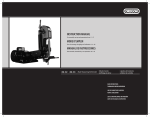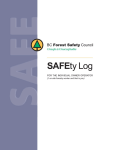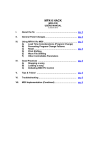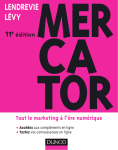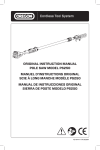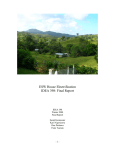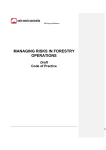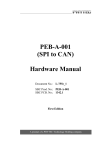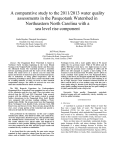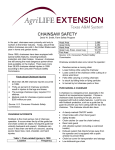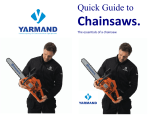Download Practical Sawyer and Chainsaw Maintenance
Transcript
By CFC Joshua Parfitt Texas Third Charlie Specialist Project March, 9, 2013 Practical Sawyer and Chainsaw Maintenance The chainsaw is a very useful cutting tool mainly used for felling trees and cutting large limbs. However if not handled properly, it can lead to serious injury. Proper maintenance skills must be used as well to keep the saw in good running condition. When properly used the chainsaw can be used to clear large amounts of wooded areas in a short timely manner. Having an effective sawyer team, which will be covered later in this manual, will maximize effectiveness and work efficiency. ALERT Cadets may have the opportunity to work along side ALERT teams on disaster relief deployments. One of the main and very important1 tools in disaster relief is the chainsaw, which can be used in a variety of ways such as clearing fallen or broken trees or larger brush caused by natural disaster. Having a small amount of training in chainsaw handling technique and maintenance can go a long way in working effectively as an ALERT Cadet disaster response team. 1 Over this past summer I have had the privilege of learning basic sawyer training during Crisis Response Training (CRT) at a LTC camp hosted at the ALERT Academy. I very much enjoyed handling the saws, learning some of the maintenance required to upkeep them and even some hands on experience. When I returned home the Lord blessed my family with some work that required cutting limbs off of trees and clearing brush. As we completed one job another filled its place and soon they begin to become bigger and more difficult jobs. We decided that it might be wise for us to invest in a chainsaw to aid us in our endeavors. Since I had some knowledge of sawyer training I was given the task of researching more and eventually running the saw. Over the months of using the saw on multiple jobs our family was blessed with I decided practical sawyer would be a good idea for a specialist project. I hope this manual is helpful and explanatory as I try to make work involved in practical sawyer a little easier to understand. 1. The Parts of a Chain Saw While there are many parts of the chainsaw both internal and external I will be mainly focusing on the main part to keep the saw running. Any problems or maintenance concerning internal parts, (engine, muffler, etc,) should be brought to a professional for further guidance. A. Engine- The engine of a chainsaw is the same as any other motorized equipment, it is the main internal part that runs the machine. Most chainsaws are two- stroke engines, two-stroke means that it competes one power cycle in only two movements of the piston. The engine is covered mainly by the cylinder cover and engine housing, or commonly referred to as the power head. B. Bar and Cutting chain- The cutting chain is the main cutting part of the saw, it resembles a bicycle chain but with sharp cutting teeth on the top and flat drive links on the bottom. The drive links hold the saw to the guide bar which guides the chain around the drive mechanism. C. Clutch cover- The clutch cover is held to the body of the saw with two large bolts. The clutch cover is easily removed by the combination spanner for cleaning and maintenance. D. Drive mechanism- The drive mechanism guides the drive links of the chain around itself and back into the grooves of the guide bar. It is located directly under the clutch cover which can be easily removed with the combination spanner. 2 E. Fuel and Chain Oil Tank- The tank for fuel is located usually on the left hand side of the saws main body, the cap indicates what the tank is for and can be unscrewed to be refilled. The chain oil tank is also on the left side of the body of the saw usually closer to the front by the guide bar. 2. Fuels and Lubricants A. Saw Fuel- Since most chainsaw engines are two-stroke, they require a fuel mixture of regular unleaded gasoline and a mixture of oil. There are two main types of fuel mixtures for chainsaws, 1:50 ratio (2%), and 1:33 (3%). The ratio of 1:50 could be shown as for every 5 liters of gasoline, you should put .5 liters of two-stroke oil in the mixture. For 1:33 fuel mixture every 5 liters should have .15 liters of oil in its mixture. Usually most chainsaws will come with a small bottle of oil that tells exactly how much fuel it should be mixed with to give you a starting point. B. Bar and Chain Oil- Chainsaws operate at very high speeds some going as fast as 3500 RPMs every minute. As the chain travels around the guide bar at such high speeds it creates a lot of friction between the drive links of the chain and the guide bar. Chain oil helps to reduce that friction and extending the life of the chain and bar. Chain saws usually will have an additional reservoir in the body of the saw for the chain oil, ( as mentioned earlier.) Most saws will automatically distribute the oil evenly around the bar and chain so it will last as long as the fuel does. Few chainsaws have a manual function where a control on the handle must be pushed manually but very few still use this function. Most chainsaw manufacturers suggest using recommended types of bar oil for chain saws. Bar oil is usually thicker then motor oil to adhere to the chain, (where as thinner motor oil will be thrown off by the speed of the chain.) 3. Safety Equipment There are few essential part of safety-equipment in working with chainsaws. Not all of the following are mandatory safety-equipment, but most of them such as helmet, hearing protection, eye protection, gloves, and chaps are basic safetyequipment. A. Helmet- The sawyer helmet (also referred to as a forester helmet,) is the main protective gear for the head and the face. The helmet is regulation safety head gear much like a hard hat but usually more form fitting. Most forester helmets come with or have an attachment for a mesh face plate. The mesh face plate 3 provides extra cover for the sawyers face while cutting but should not be used in the place of proper eye wear. B. Eye wear- Eye wear is one the most important parts of sawyer safetyequipment since the eyes are very vulnerable to flying wood chips and sawdust. Just one little speck of sawdust or chip of wood can cause a well planned day of work to go awry. Normal everyday sunglasses usually are not the best option for eye protection, glasses should cover the eyes completely or wrap around the head a little. Work goggles are best suited for this as they completely enclose your eyes and usually stay in place better then plain glasses. C. Hearing protection- Although this part of equipment may seem as secondary and often put off, the constant roaring a a chain saw or multiple saws for a few hours will leave uncovered ears ringing and in the long term cause hearing problems. The advanced forester helmets often will have hearing protection built into them. D. Chaps- Special kinds of fabric developed for chainsaw clothing, that is very common in chainsaw clothing today. Conventional fabric is useless at protecting against a running chainsaw, being immediately cut through. There is a real struggle between making a fabric proof against more violent impact, and making it light, flexible and comfortable enough for the user. Clothes which make the user too hot, or which prevent the user moving easily, are a safety problem in themselves. A worker suffering from being too hot is not safe. Extra fabric layers can be added to clothing to improve cut resistance, but clothes which cannot be cut at all by a powerful saw are impractical, even with modern fibers. There are two standard types of chaps, type A and type C. Type A protects only the front of the legs, and can be supplied as chaps, worn over conventional work clothes, or as conventional trousers. Type C gives protection all round the legs and are almost always worn as ordinary trousers, not over another garment. Chaps are generally used for occasional, farm or homeowner applications. Professional chainsaw operators would choose trousers for comfort and ease of movement, with fallers, ground workers and firewood cutters opting for class A trousers because of the low risk of being cut in the back of the leg. Climbers and tree surgeons would have to wear type C, as they will be cutting from a wider variety of positions. Type C trousers are, of course, highly insulating, and may lead to heat stress if worn for labour intensive operations such as firewood cutting. Chainsaw protective fabric works on a number of principles. The outermost layer can be made both tough and slippery, to protect against trivial damage which 4 could compromise the filler material. Beneath this, long, loose fibres of Kevlar laid in layers. When a saw contacts the trousers, the outer layer is immediately cut through but the nylon or Kevlar is drawn out and wraps around the saw's drive sprocket, locking it solid and halting the chain, limiting damage to the operator's leg. After stopping a saw, the trousers are scrapped, and the saw must be fieldstripped to remove the fibres and allow it to run again. E. Gloves- There are not really a specific set type of gloves for sawyer work. Leather gloves would good grip would probably be the best glove to choose. There are chainsaw gloves that have padding on the back of the left hand since it is the hand closest to the cutting chain and the most likely to be affected by occurrence of kickback. F. Boots- Best type of boots for sawyer work would be steel toe work boots. 4. Basic Safety Procedures when Handling a Chainsaw A. The chain brake- The chain brake is the most important safety feature on a chainsaw, it is really the only way to completely stop the chain from spinning around the guide bar while it is running. The chain brake is located directly in front of the front handle by your left hand. The chain brake is activated by your left hand only, to activate it you should tilt your left wrist forward and push the brake lever forward while never letting go of the saw. To deactivate the chain brake you should keep your thumb on the front handle while using your other fingers to pull the brake towards you while as before never letting go of the saw. The chain brake should be activated in between cuts and pretty much every time you are not using it to cut. One tip however once the saw is turned off completely, the chain brake should be deactivated before removing the clutch cover or you will not be able to put the clutch cover back on after you are done cleaning it. B. Carrying the Saw- You should always have both hands on the saw whenever you are making cut. When the saw is idling or off, you may carry it by the front handle with the bar facing behind you. 5 5. Daily Basic Maintenance There is basic maintenance that should be done every time you are done using your chainsaw or before using it again. The only two tools you will really need for a chainsaw is the combination spanner that usually comes with the saw, a chain sharpening kit. Other then that all you really need are old rags or heavy duty paper towels. A. Sharpening the chain- The chain should always be sharpened after prolonged use. You will be able to tell when the chain needs sharpening when it does not cut as smoothly, you might be able to smell the wood almost burning, that means that too much friction is being caused from the chain being too dull. More sign are the size of the wood chips being produced; when they are more fine almost like sawdust, your chain is rubbing away the wood more then chipping it away. Since there are many different types of chains and ways to sharpen them it would probably be best to refer to your user manual. B. Cleaning under the clutch cover- Underneath the clutch cover is where most clean up is needed. Sawdust mixed with oil often builds up underneath the cover and must be cleaned out. The easiest way to do this is to remove the two nuts holding the clutch cover into place with the combination spanner. As I said before make sure the chain brake is off before you remove the clutch cover, or it is near impossible to put the clutch cover back into place. Once the clutch cover is removed you can also remove the bar and chain from the drive sprocket. Scrape any visible sawdust that is built up directly under the clutch cover and around the drive sprocket using the combination spanner. Once most of the debris is cleared you can then use a rag or paper towel to wipe it thoroughly clean. C. Refitting the Bar and Chain- Once you clean underneath the clutch cover 6 you will have to re attach the guide bar to the bar bolts. Place the bar in its rearmost position and begin reattaching the chain starting from the top of the bar. Make sure all of the drive links fit evenly and snugly into the drive sprocket and the groove in the guide bar. Make sure that the cutting edges of the cutting links are facing forward on the top edge of the bar. Put the clutch cover back on and tighten the bolts finger tight. Then find the chain tension screw and tighten the chain until it does not sag from the bar, but can still be turned by hand. When it is tensioned properly, hold the tip of the bar up and tighten the nuts holding the clutch cover in place all the way. 6. Working procedures There are many safety procedures that should be followed while running a chainsaw. Listed below are some of them that you should go through before actually cutting. While it is not a complete list, they are a good set of standard rules to always keep in mind. A. Basic Safety Rules: 1. You want to make sure the surrounding area is clear from things that would interfere with your proper handling of the saw. 2. Make sure no people or pets are under the immediate area you will be cutting as to avoid any injuries that may be caused by falling branches and other dangers associated with the chainsaw. 3. You want to make sure that you do not use the saw in bad weather such as snow rain sleet or heavy fog. Intense cold weather can make muscles cramp and fingers stiff making it more difficult to operate the chainsaw. Intense heat may bring on symptoms such as heat stroke or heat exhaustion making the operation of the saw dangerous for the user. 4. You will also need to take care when cutting small branches or bushes. The chain can grab smaller pieces of wood and throw them back at you or at surrounding areas. 5. You will also want to make sure that the area where you are working has firm even ground to stand on. Slippery slopes, uneven ground, or hidden holes can be very dangerous to a chainsaw operator. B. Sawyer team- A sawyer team should be assembled to provide the best means of effectively working with multiple people. There are three people involved in a sawyer team, one is the sawyer, second is the swamper, and three is the brush puller. C. The Sawyer- The sawyer is obviously the person handling the chainsaw itself. 7 He is responsible for cutting and safe handling of the chainsaw. The sawyer is the closest person to the saw D. The Swamper- The swamper is the next closest person to the chainsaw. The swamper's main responsibility is to keep the felled wood or brush that the sawyer cuts. It is very difficult to cut safely when you are constantly getting tangled up in fallen brush. The swamper however needs to be constantly aware that the sawyer cannot see or hear him as well as he can, so the swamper must pay attention to the sawyer at all times. E. The Brush-puller- The brush-puller is the third man who as the swamper pulls the brush away from the sawyer, then drags the brush farther away and piles it accordingly. He may pile it according to size or place it where it is easily cut into smaller pieces if needed. 7. Dangers to be Alert For There are many dangers associated with using a chainsaw. Below are a few of the main most common causes of accidents and how to avoid them. A. Kickback- Kickback is one of the more common causes of serious chain saw injury accidents. 8 Kickback may most commonly occur when the moving chain at the nose or tip of the guide bar touches an object, or when the wood closes in and pinches the saw chain in the cut. Tip or bar nose contact can, in some cases, cause a lightningfast reverse reaction, kicking the guide bar up and back toward the operator. Pinching the cutting chain along the top of the guide bar may cause the guide bar to literally kick back rapidly toward the operator. Either of these reactions may cause you to lose control of the saw, which could result in serious personal injury to yourself or anyone in the immediate surrounding area. Ways to avoid this is to of course try not to cut with the tip of the saw directly when making a cut. B. Pull in reaction- Pull in reaction occurs when cutting timber with the underside of the chainsaw. When making an upward cut, the saw chain can cause the wood to be pulled into the operator, or the operator pulled into the wood or worse into the saw. C. Push back reaction- This can occur when Under-cutting timber with the topside of the saw chain. The force of the spinning chain can cause the saw to be pushed away from the timber and towards the operator. 8. Cutting Technique Generally only the upper and lower edges of the guide bar should be used for cutting and never the tip. This will help lessen the amount of kickback. The chain saw will cut best when not placed under unnecessary force while operating at a high cutting speed, or full throttle. Control of the chainsaw should be maintained by a firm two handed grip at all times. A chainsaw should never be operated above shoulder height, the power head should be kept as close to the body as possible. Apply the chain brake always when setting it down or carrying it on idle. When moving something beside the saw always place the saw on the ground before trying to multitask. When you are finished working, the chain brake should be applied and the saw turned off, the bar cover should be placed on the bar at all times to prevent injuries from the sharp chain. A. Vertical Cuts- Vertical cuts should be use as much as possible with the rear handle being supported by the upper right leg, and the powerhead stabilised against the forward left leg. In the vertical cutting position, your eyes should be focused to the left hand side of the cutter 9 bar. Maintain a firm grip and balanced stance, so that should ‘kickback’ reaction occur, the saw will only be forced up past the right side of your body. B. Horizontal Cuts- Horizontal cuts will require that the left leg in this case be in the rear , clear of the guide bar. Control is aided by the right arm or back of the right hand being supported on the right knee. You should use the muscles in your legs and not in your back as you will tire quickly and might pull your back out! Keep your back as straight as possible and bend your legs at the knees when you need o adjust. C. Trimming (bucking)- While the chainsaw is very useful for cutting large amounts of wood or even cutting down whole trees, it can also be used very effectively for trimming larger branches or even small branches very quickly. D. Trimming- Sometimes a tree may have an excess of branches or dead branches that need to be removed to support the trees health. Branches for example that are rubbing together or pointing straight downward toward the ground usually need to be removed. While trimming limbs can seem as an easier task compared to some cutting jobs, there are still cautions that need to be taken as there are many potential hazards such as : • Branches under tension can whip back when the pressure is cut • Other branches may be affected or pulled down when one is removed • Dead branches have a tendency to fall the slightest change is made in a tree There are a few basic rules that it would be important to be remembered when trimming or removing branches. • Assess the situation of the branches, are they under compression or tension? Cut compression wood first then wood under tension last. 10 • Stand in a safe working position free of obstacles. • Never cut a branch that you are directly standing under. • Concentrate, focus. • Always be aware of not only what you are doing but others around you. • Smaller limbs may be cut flush with the tree with one cut. Larger limbs may need to be cut in half then cut in flush if necessary. • At times it may be necessary to work the saw horizontally. Adjust your grip on the chainsaw’s handles to suit the position of the saw. • Whenever it is possible, use the saws spikes to support its weight. When this is not possible support its weight with your thigh. E. Assessment of limbs under stress- Two major safety problem that arises with most any cutting involving sawyer work is compression and tension. The easiest way to explain compression is two forces that are pushing together. Cutting directly into a tree or branch in compression will almost always result in the bar and chain becoming stuck in the cut. Once this happens it is often very difficult to remove the bar and chain. Tension is where the object is being pulled apart or stretched. For example, a branch extending from the tree is being pulled down by the force of gravity. The branch resists the downward pull of gravity, which places the branch fibers under stress. The underneath side of the branch is under compression, the upper side of the branch is under tension, and the middle of the branch is neutral. Once you start to cut the branch you change the internal stresses on the fibers. Whether you cut from the bottom or the top, you will reduce the amount of neutral fibers so that more fibers are now under tension or compression. Fibers under compression will store energy depending on the weight of the branch. When the branch is cut, or breaks under the stress, this compressed energy is released and can cause the branch to whip back violently towards you. To prevent this you should cut through the compression wood first, slowly, until the branch starts to move. This means there is no neutral fiber remaining. Then cut the tension wood. If the branch is supported at both ends, the bottom side of the wood is under tension and the top side is under compression. Hanging branches, (supported at one end only) attached to the trunk should be first under cut no deeper then 1/3 of the branch, then cut off completely from the 11 top. Sprung branches (supported at both ends) in contact with the ground must be first under cut in compression then top cut to relieve tension. Conclusion While this is not the complete ultimate chainsaw reference manual, I hope that I have provided a few helpful basic rules and tips. Basic maintenance to upkeep your chainsaw, safety equipment, safe handling, and basic working procedures are a few things that are a good idea to understand to be effective in sawyer work. As I said before any other questions about more difficult chainsaw problems should be referred to your user manual or chainsaw manufacturer. Bibliography 12 Husqvarna Chainsaw manual part 1 Publishing draft march 2009 455 Rancher Operators manual manualslib.com http://forestry.about.com/od/forestryhelp/ss/byw_saw_6.htm http://www.oregonproducts.com/pro/service/kickback.htm http://www.treeworld.info/f9/compression-vs-tension-wood-1617.html 13













